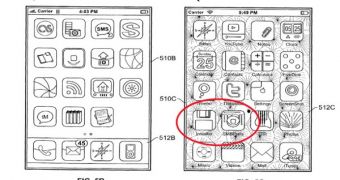A recently published patent application by Apple for biometric security on iPhones includes imagery (left) of what seems to be a jailbroken iPhone showing the icons for Installer.app and the SMBPrefs jailbroken app. In accordance with Apple's interpretation of the DMCA as it relates to Jailbreaking, using these apps on the iPhone is illegal.
According to Engadet, which was provided with the picture, the imagery shows a jailbroken phone, complete with Installer.app, SMBPrefs, and the iWood Realize theme from the iSpazio repository. Apple's legal, Kramer, Levin Naftalis & Frankel are likely going to face consequences. Imagery for patent applications is usually handled by artists. In this case, the site points out, using these specific icons or this theme wasn't necessary to illustrate Springboard variations.
As for the patent application itself, a summarized description is available below, as published over at the US Patent & Trademark Office.
EMBEDDED AUTHENTICATION SYSTEMS IN AN ELECTRONIC DEVICE
[...] This invention is directed to an electronic device with an embedded authentication system for restricting access to device resources. The authentication system may include one or more sensors operative to detect biometric information of a user. The sensors may be positioned in the device such that the sensors may detect appropriate biometric information as the user operates the device, without requiring the user to perform a step for providing the biometric information (e.g., embedding a fingerprint sensor in an input mechanism instead of providing a fingerprint sensor in a separate part of the device housing). In some embodiments, the authentication system may be operative to detect a visual or temporal pattern of inputs to authenticate a user. In response to authenticating, a user may access restricted files, applications (e.g., applications purchased by the user), or settings (e.g., application settings such as contacts or saved game profile).
The invention was filed September 9, 2008 and published last week, March 26, 2009. Those credited for working on the invention are Fadell Anthony (Portola Valley, CA); Hodge Andrew (Palo Alto, CA); Schell Stephan (Cupertino, CA); Caballero Ruben (San Jose, CA); Dorogusker Jesse Lee (Los Altos, CA); Zadesky Stephen (Portola Valley, CA); Sanford Emery (San Francisco, CA).

 14 DAY TRIAL //
14 DAY TRIAL //